| Reviews & Columns |
|
Reviews DVD TV on DVD Blu-ray 4K UHD International DVDs In Theaters Reviews by Studio Video Games Features Collector Series DVDs Easter Egg Database Interviews DVD Talk Radio Feature Articles Columns Anime Talk DVD Savant Horror DVDs The M.O.D. Squad Art House HD Talk Silent DVD
|
DVD Talk Forum |
|
|
| Resources |
|
DVD Price Search Customer Service #'s RCE Info Links |
|
Columns
|
|
|
Scarface: Limited Edition SteelBook
THE FILM:
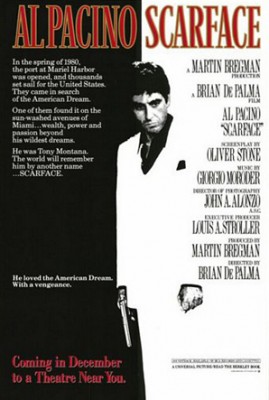
Few gangster films are as notorious as Brian De Palma's opus of excess Scarface, itself a remake of Howard Hawks' classic 1932 film. Cuban import turned drug kingpin Tony Montana enjoys greater name recognition than any other cinematic criminal with the possible exception of The Godfather's Don Vito Corleone. Somehow Montana has come to personify America's success-is-for-the-taking idealism, and his name is dropped in everything from rap videos to nightly newscasts. The cult of Scarface can be deafening, but De Palma's film is nothing short of riotous entertainment. With its career-defining performance by Al Pacino, Scarface overindulges in the 1980s Miami lifestyle of cocaine and cocktails to become one of cinema's greatest celebrations of lawless behavior.
The opening minutes of Scarface play like a documentary, and De Palma uses real footage of Cubans fleeing to Miami during the Mariel boatlift that occurred when Fidel Castro opened the Cuban port nearest the United States in 1980. Some of the exiles left Cuba to join their families, but many were released from jails and mental asylums, and the U.S. was forced to open refugee camps to sort out the immigrants. Tony Montana (Pacino) arrives with gusto, demanding his human rights, and he quickly ends up at a camp located under Interstate 95 alongside his buddy Manny Ribera (Steven Bauer). To expedite their release from the camp, Tony and Manny agree to kill a former Cuban government official for Miami drug dealer Frank Lopez (Robert Loggia). After being sprung from captivity, Tony and Manny wash dishes at a crummy restaurant. Tony refuses to continue work as a dishwasher, and strong-arms Frank's associates into letting him run a cocaine buy. The deal goes south quickly, resulting in the film's infamous chainsaw death of Tony's friend Angel (Pepe Serna), but Tony returns to Frank with both the buy money and two kilos of cocaine. Frank considers Tony a peasant, but recognizes that Tony's ballsy way of doing business makes him a valuable man to have around.
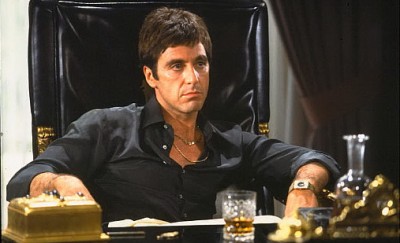
Scarface immediately revels in the flash and excess of the '80s. Frank's office looks like a beach trip on acid, and his mansion is all glass, mirrors and gold accents. As Tony reclines on the couch, he notices Frank's leggy, blonde girlfriend Elvira Hancock (Michelle Pfeiffer) descending the stairs. Clearly unimpressed with her husband's company, Elvira retreats to the bar while sarcastically discussing Frank's plans for the evening. As with most things sharp and expensive, Tony takes an immediate liking to Elvira. Frank continues to run Tony on medium-level deals, including a trip to Bolivia to meet cocaine cartel Alejandro Sosa (Paul Shenar), who takes Tony aside and explains his distaste for the drug industry. Tony instantly moves up the ranks after Sosa throws henchman Omar Suarez (F. Murray Abraham) from a helicopter with a noose around his neck. It is difficult to pinpoint the exact moment when Tony's crazed ambition shifts from talk to action, but I think it happens right about the time Omar's neck snaps.
I was but a child during most of the '80s, so I cannot say whether or not the cocaine culture depicted in Scarface was prevalent everywhere or just especially popular in Miami. Although Frank's rules for drug running include not getting high on the supply, the characters in Scarface constantly partake. In one great shot, Elvira snorts a few lines before taking a long drag on her cigarette and gulping half a strong cocktail. Elvira is the type of woman that either finished the '80s in a coffin or is currently working at a tanning salon in Myrtle Beach. Scarface has few female characters other than Elvira, but the film also includes Tony's mother (Míriam Colón) and younger sister Gina (Mary Elizabeth Mastrantonio). Gina loves Tony unconditionally and forgives him for leaving the family for years after he got in trouble in the Cuban army, but Tony's mother is disgusted by his occupation. Unfortunately for Gina, Tony gets enraged when he sees her dancing at a club, and sends her male companion running for the exit. Manny tells Gina that Tony's actions are out of love, so Gina asks Manny to take her out. But Tony has forbidden this, too. Scarface has been called misogynistic, but Tony never lays a hand on Elvira. Tony and Gina's interaction late in the film has always been creepy, especially when she pushes him about his jealousy.
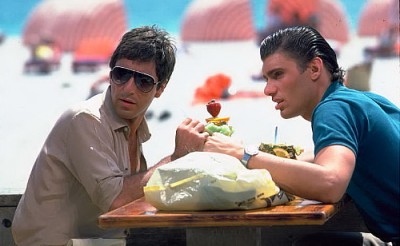
When Tony drives Frank out of business, he becomes the leading dealer in Miami, which affords him a lifestyle of mansions, pools and piles of cocaine that is much-appreciated by rappers. Tony's powder renaissance is short lived, however, as the government gets serious about fighting cocaine distribution. Tony and Elvira become addicted to cocaine and booze in grand fashion, and Tony's paranoia strains his marriage and friendship with Manny. And Tony quickly learns that crossing a Bolivian cartel has serious consequences.
Critics of Scarface say the film moves quickly toward overkill with its depictions of violence and drug use. Twenty-eight years after the film's initial release, the violence in Scarface seems relatively tame, but De Palma had to fight for his R rating in 1983. Drug running is a business based on power and intimidation, and violence is a natural and terrible consequence to this lifestyle. Nothing in Scarface, including its hyperbolic finale, strikes me as particularly inappropriate, and the drug use is absolutely necessary to the story. Elvira is arguably a junkie from the time Tony meets her, and Tony gets hooked on blow when his business goes south. Tony snorting from a mountain of cocaine is an important contrast to the glamorous portrayal of the drug's recreational use in Miami's hottest clubs.
Tony is not a completely rational character, and, as the film moves forward, it is difficult to understand his actions, particularly in regard to his family. Scarface does an excellent job showing how Tony's judgment is clouded by heavy drug use. Tony acts with such brash callousness that it is difficult to know what he is thinking, but that defines his character. It is not clear exactly why Tony allows his life to fall apart, but Scarface is a better film for Tony's unpredictability.
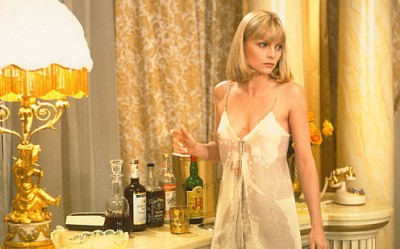
You are not likely to find a 170-minute film that keeps the pace of Scarface. Working from a script by Oliver Stone, De Palma crafts a fully realized saga that is perpetually moving. Tony's rise to drug kingpin is explored in depth, but Scarface never spins its wheels. There are moments of high drama, quick humor and great suspense, and film's constant forward progress demands its urban battlefield climax. The performances are strong across the board. Pacino has been praised for his acting - what some call overacting - in the lead role, and it is tough to argue that Pacino doesn't completely become Tony. Pfeiffer is spot-on as Elvira, and, while Tony makes a valid point that Elvira needs a job and direction in life, her tense showdown with Tony at dinner about her empty life is one of the film's best scenes. Bauer is also excellent as Manny, one the film's most likable characters, and I cannot think of a single supporting actor that fumbles his role.
That some consider killer and drug-peddler Tony Montana an American hero is a bit concerning, but Scarface is popular cinema at its most entertaining. No matter how hard Pacino tries to sully his image, he will forever be Tony Montana, political prisoner from Cuba. De Palma has not made a film as brash and ambitious as Scarface, and Stone's writing has not been as over-the-top effective since. Scarface may be violent, profane and flashy, but it is one of the best gangster films ever made.
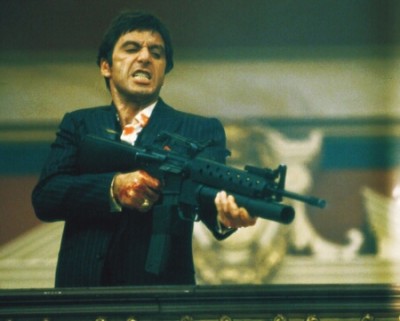
THE BLU-RAY:
PICTURE:
Scarface arrives on Blu-ray with a 2.35:1/1080p/VC-1-encoded transfer that has provoked much discussion across the Internet. Quite simply, this is the best Scarface has looked on any home-entertainment format, but the presentation is nonetheless imperfect. If I had to describe the transfer in one word, I would choose "inconsistent." Detail is very impressive in many of the film's daytime scenes. The bright Miami landscapes explode from the screen, and every pore, bead of sweat and trace of cocaine on Tony's tanned face is visible. Shots are frequently deep, and texture is usually good in brightly lit shots. Where detail falters is during nighttime scenes, when black crush runs rampant. There are not a ton of nighttime scenes in Scarface, but when they do occur, the level of detail I mentioned earlier is reduced drastically. I appreciate the transfer's inky blacks, but I wish they didn't come at the expensive of detail and texture. Colors are bright and well saturated, though the image does run a bit hot to match its Miami setting. Skin tones are generally natural, but look a bit orange at times. Much has been made about Universal digitally tinkering with the look of Scarface. While I won't try to convince you that the film is completely free of digital manipulation, I think the problem is less severe than many claim. Edge enhancement is occasionally present, but halos are not a persistent problem. Digital noise reduction may have been used in spots, as I noticed some overly smooth faces and clunky grain structure. But generally, Scarface retains a nice layer of grain and a film-like appearance. This leads me to believe that these dreaded digital tools were used sparingly. Aliasing issues do pop up, and I noticed some especially nasty shimmering in the trees and on buildings during the scene when Tony makes his first buy in the downtown hotel. Although Universal put the film and a bunch of extras on one BD-50 disc, I noticed no compression or artifacting issues. Yes, the Blu-ray's transfer has a couple of problems, but much of Scarface looks great. None of the issues should be a deal breaker, and the film has never looked better.
SOUND:
I have no quibbles with the 7.1 DTS-HD Master Audio soundtrack, as it is flawless. I'm not sure the two extra channels are necessary, but it's nice to have them on board. Dialogue is clean and free from hiss, and every "fuck" is absolutely audible. Directional dialogue is present when appropriate, and it, as well as ambient effects, fills the entire sound field. Active effects are positively bombastic, and the track has a reckless LFE response that shakes the floor. Gunfire, explosions and a chainsaw can be heard from the front and the rear, and these effects are placed alongside quieter sounds, like nightclub babble and rolling waves, to create an immersive environment for the viewer. Parts of the track sound slightly thinner than a modern mix, but Scarface sounds incredible for a 28-year-old film. An English 2.0 DTS track and French and Spanish mono tracks are available, as are English SDH, French and Spanish subtitles.
PACKAGING AND EXTRAS:
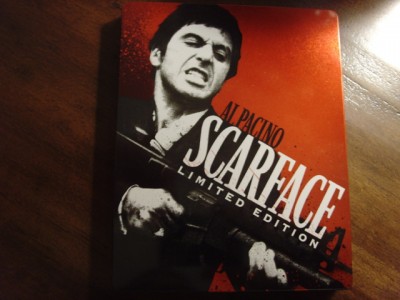
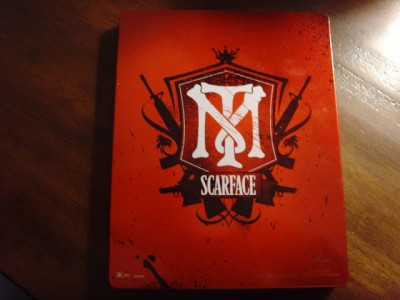
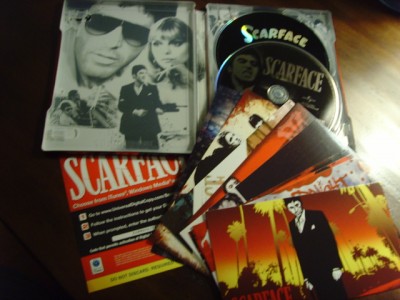
The "Limited Edition" of Scarface arrives on Blu-ray with gorgeous SteelBook packaging. The blood-red case features an image of Tony firing his "little friend" on the front and Tony's "TM" logo amid a slew of guns on the rear. Inside the case, the discs are housed atop black and white pictures from the film. Ten contest-winning art cards for the film are included, as is a downloadable digital copy of Scarface. The extras are numerous and worthwhile:
- Scarface (1932) - Universal includes a separate DVD copy of Howard Hawks' 1932 masterpiece Scarface. This is the same edition of the film that was released separately in 2007 as part of Universal's Cinema Classics series. The original Scarface is an excellent gangster film, and features an intense performance by Paul Muni as Antonio "Tony" Camonte. Those unfamiliar with this version will likely enjoy it, and the film's inclusion here increases the Blu-ray's value exponentially. The 1932 film receives a respectable 1.33:1 transfer and mono soundtrack, and the disc includes full menus, an alternate ending and an introduction by film historian Robert Osborne.
- U-Control - Universal includes two interactive features that viewers can choose to play while watching the film. The first, a Picture-in-Picture Track, features video interviews with the cast and crew. There is also a scene comparison between the 1983 and 1932 versions of Scarface. Some of the material is repeated in other bonus features, but this is a nice track. Scarface Scorecard is a silly feature that counts each time the word "fuck" is used or there is gunfire.
- The Scarface Phenomenon (38:34) - This newly created, three-part retrospective documentary is presented in high definition and includes interviews with De Palma, horror director/actor Eli Roth, film critic Julie Salamon, rapper Sen Dog, author Roberto Saviano and filmmaker Antoine Fuqua, among others. If nothing else, this documentary makes clear that a lot of people really love Scarface.
- Deleted scenes (22:29) - In these scenes, Tony bonds with Manny, goes to another drug deal and approaches the local district attorney at a restaurant.
- The World of Tony Montana (11:38) - Police officers, authors, filmmakers and fans of Scarface discuss the rise of Tony Montana from Cuban immigrant to drug kingpin.
- The Rebirth (10:08) - In this featurette, De Palma discusses the 1932 Scarface and how it inspired him to create a modern gangster epic.
- The Acting (15:05) - The focus of this piece is the actors, namely Pacino and Pfeiffer.
- The Creating (29:35) - This is essentially the disc's making-of documentary, and De Palma, Stone and Producer Martin Bregman discuss the creation of the controversial film.
- The Making of "Scarface: The Video Game" (12:05) - This throwaway featurette explores the creation of the popular video game that was inspired by the film.
- Scarface: The TV Version (2:48) - Scarface includes a lot of violence and profanity, and this short featurette reveals some of the hilarious changes made for network television.
- Universal also includes D-Box Motion Code, the My Scenes bookmarking feature and a BD-Live Portal. The only things missing are the superfluous Def Jam Presents: Origins of a Hip-Hop Classic featurette available on the 2003 DVD and the film's theatrical trailer, which is actually available via BD-Live.
FINAL THOUGHTS:
Few films are as quoted and beloved as Brian De Palma's 1983 gangster masterpiece Scarface. Al Pacino explodes from the screen as Miami cocaine kingpin Tony Montana, and his audacious performance is the stuff of cinematic legend. An entertaining exploration of excess, crime and consequence, Scarface is pure action entertainment. Universal's Limited Edition SteelBook Blu-ray edition of Scarface is the best way to watch the film at home. The transfer has a few problems but is generally strong, and the film's 7.1 lossless soundtrack is reference quality. The Blu-ray includes a host of interesting bonus features, the best of which is a DVD copy of the original 1932 Scarface. For collectors and casual fans alike, Scarface is a must-own Blu-ray. DVD Talk Collector Series.
William lives in Burlington, North Carolina, and looks forward to a Friday-afternoon matinee.
|
| Popular Reviews |
| Sponsored Links |
|
|
| Sponsored Links |
|
|
| Release List | Reviews | Shop | Newsletter | Forum | DVD Giveaways | Blu-Ray | Advertise |
|
Copyright 2024 DVDTalk.com All Rights Reserved. Legal Info, Privacy Policy, Terms of Use,
Manage Preferences,
Your Privacy Choices | |||||||












